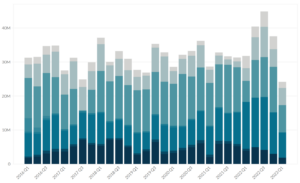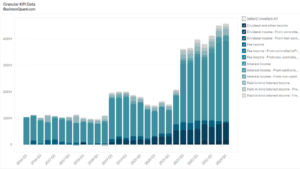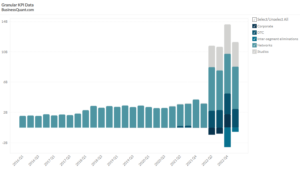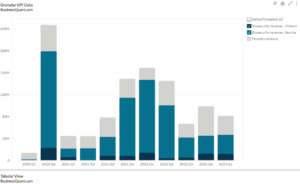
Arista Networks’ Revenue by Segment (2016-2023)
Exclusive Data
You need the Pro Plan to access KPI data
- Full access to the platform
- KPI data & segment financials on US stocks
- Financial data on thousands of stocks
- Download data in xlsx and csv formats
Pro Plan
$49 per month*
60% discount ends in:
.
About
More information
Subscribe to Pro or Enterprise plans to unlock this feature.
Contact the Analyst
Subscribe to Pro or Enterprise plans to unlock this feature.
Become a smarter investor today.
Access KPIs & Segment Financials on US stocks
This statistic highlights Arista Networks’ Revenue by Segment from Q1 2016 onwards, split between Product and Service on a quarterly basis.
Arista Networks’ Revenue by Segment
The following table highlights Arista Networks’ Revenue by Segment for Q3 2020, Q2 2021 & Q3 2021:
| Segment | Q3 2020 | Q2 2021 | Q3 2021 | Contribution in Q3 2021 |
| Product | $480.20 | $566.50 | $604.20 | 80.69% |
| Service | $125.20 | $140.90 | $144.50 | 19.31% |
| Total | $605.40 | $707.30 | $748.70 | 100.00% |
(All figures are in millions, except percentages)
On a QoQ basis, the total revenue generated, increased by 5.8%. Even on a YoY basis, there was an increase of 23.7% in the total revenue. The total revenue varies from period to period based on many factors such as the timing, size, and complexity of orders, especially for their large end customers. On an overall level, the revenue has increased thrice as compared to Q1 2016. However, it was affected by the pandemic and there was a shortfall.
Product
A majority of Arista’s total revenue, about 80%, comes from this vertical. Product revenue primarily consists of sales of the company’s switching and routing products and software licenses. They offer products such as Core Datacenter/Cloud Switching Products, Adjacent Campus and Routing Products, and Network Software and Services.
- Core Datacenter: Arista offers one of the broadest product lines of datacenter Gigabit Ethernet switches in the industry, comprising of various models.
- Adjacent Campus and Routing Products: This product category further includes – Cognitive Campus Switching and Routing and Cognitive WiFi products. Arista’s adjacent products include Cognitive Campus switching products as well as Universal Spine and Leaf Routing products. On the other hand, Cognitive WiFi consists of access point solutions that are tailored for a controller-less wireless network.
- Network Software and Services: This category includes products such as CloudVision, DANZ Monitoring Fabric, Arista Network Detection and Response, CloudEOS, and Arista A-Care Services. All these products help in automating, enhancing security, and analyzing network communications.
Product revenue increased by 6.6% on a QoQ basis. Even on a YoY basis, there was an increase of 25.8% in the revenue generated. This reflects stronger demand for Arista’s products from new and existing customers, as well as improved market acceptance of their enterprise and campus products. Overall, there is an increasing trend in the revenue from product vertical, and in all the quarters, there was an increase in the revenue. However, during the first half of 2020, there was a shortfall in the revenue generated due to the pandemic. This was recovered later, in the forthcoming quarters.
Service
Service revenue is primarily derived from sales of Post-Contract Support (PCS) contracts. These are typically purchased in conjunction with Arista’s products, and subsequent renewals of those contracts. PCS includes services such as technical support, hardware repair and replacement parts beyond standard warranty, bug fixes, patches, and unspecified upgrades. This revenue is deferred and recognized ratably over the life of the PCS contract. Revenue is deferred as there is no discernible pattern of delivery related to these promises. Arista addresses customer requests for technical support as and when they arise, with the related expenses recognized as incurred. These contracts generally have a term of one to three years.
Service revenue increased by 2.6% on a QoQ basis. Even on a YoY basis, there was an increase of 15.4%. This was due to an extended growth in initial and renewal PCS contracts as the customer base of Arista’s continued to expand. Overall, even this category had an increasing trend in revenue, however, there was no shortfall in the revenue generated due to the pandemic, and remained largely unaffected.
About the Company
Arista Networks, an American computer networking company, provides data-driven, cognitive cloud networking for large-scale datacenter and campus workspace environments. They are a leading cloud networking solutions provider, listed on the NYSE with the stock ticker ANET, delivering high performance, scalability, availability, programmability, workload orchestration, automation, and visibility.
In recent years, Arista has sought to bring the operational consistency and principles of cloud networking to the broader enterprise and campus markets with their Cognitive Cloud Networking, extending EOS. Their cloud networking solutions consist of Extensible Operating System (EOS), a set of network applications, and Ethernet switching and routing platforms.
Some of Arista’s end customers include Microsoft and Meta, from whom the company has generated 40% of its total revenue in 2019. Historically, large purchases were made primarily by a relatively limited number of end customers. However, these have accounted for a significant portion of Arista’s revenue.
Did you like Arista Networks’ Revenue by Segment statistic?
Access more such KPI data points and segment financials on thousands of US stocks, with Business Quant.
You can get started here.
More data on US Stocks

Our Plans
Always know what you’ll pay. No hidden costs or surprises.
- Annual
- Monthly
60% discount till April 30
Pro
For serious investing
-
Company KPI data Access segment financials, non-GAAP metrics and KPI data from presentations and filings. Examples include financials by segment / region / product category, AT&T's broadband subscriber trends, Tesla's deliveries by model and lots more.
-
Stock research tools Features include : stock screener, stock comparison, industry financials, stock warnings, advanced charting tools, timeseries tables, scatter charts, financial statements, stock reports, SEC filings, stock ratings, institutional and insider ownership data. There are 200+ financial items and ratios on thousands of US stocks.
-
Industry data & tools Access premium operating data on 40+ industries. Examples include market share, smartphone shipments by vendor, subscribers by wireless carrier, historical gold production. There are 20,000+ such statistics.
Enterprise
For tailored workflows
-
All of Pro plan Get unfettered access to all our dashboards and dossiers.
-
Custom built features Get tailored dashboards built specially for you , based on your set of requirements, to simplify your research workflow.
-
Admin billing Back-end documentation support and multi-seat licensing.
* Billed annually, local taxes extra.
60% discount on Annual plan
Pro
For serious investing
-
Company KPI data Access segment financials, non-GAAP metrics and KPI data from presentations and filings. Examples include financials by segment / region / product category, AT&T's broadband subscriber trends, Tesla's deliveries by model and lots more.
-
Stock research tools Features include : stock screener, stock comparison, industry financials, stock warnings, advanced charting tools, timeseries tables, scatter charts, financial statements, stock reports, SEC filings, stock ratings, institutional and insider ownership data. There are 200+ financial items and ratios on thousands of US stocks.
-
Industry data & tools Access premium operating data on 40+ industries. Examples include market share, smartphone shipments by vendor, subscribers by wireless carrier, historical gold production. There are 20,000+ such statistics.
Enterprise
For tailored workflows
-
All of Pro plan Get unfettered access to all our features.
-
Custom built features Get tailored dashboards built specially for you , based on your set of requirements, to simplify your research workflow.
-
Admin billing Back-end documentation support and multi-seat licensing.
* Local taxes extra.






